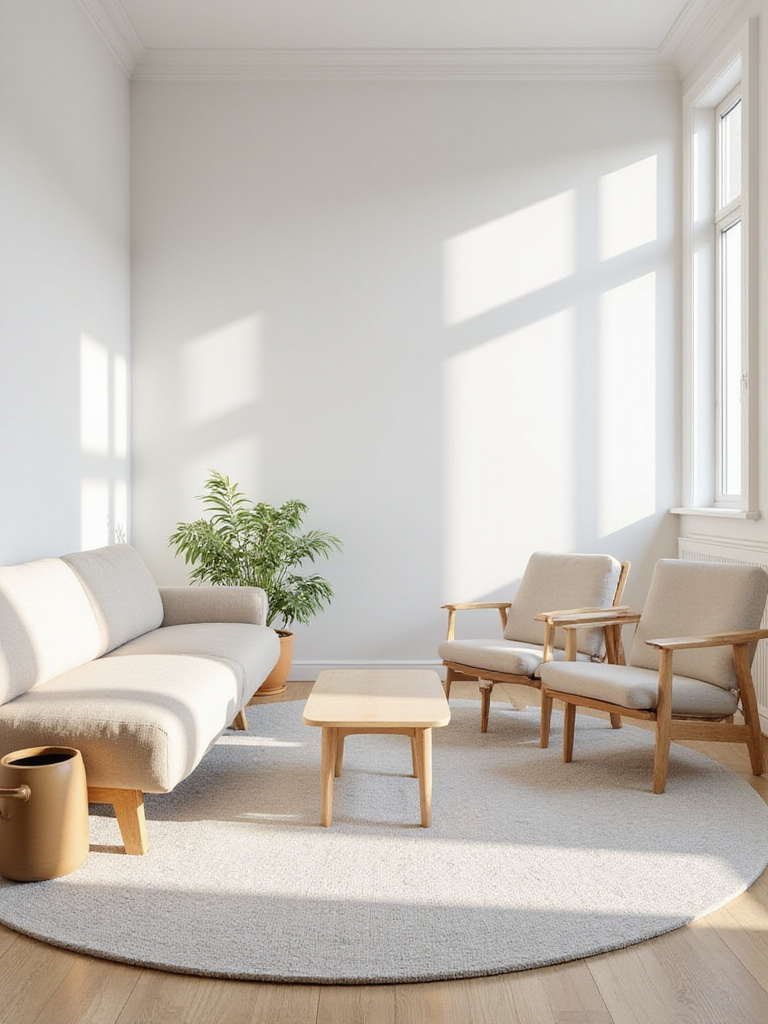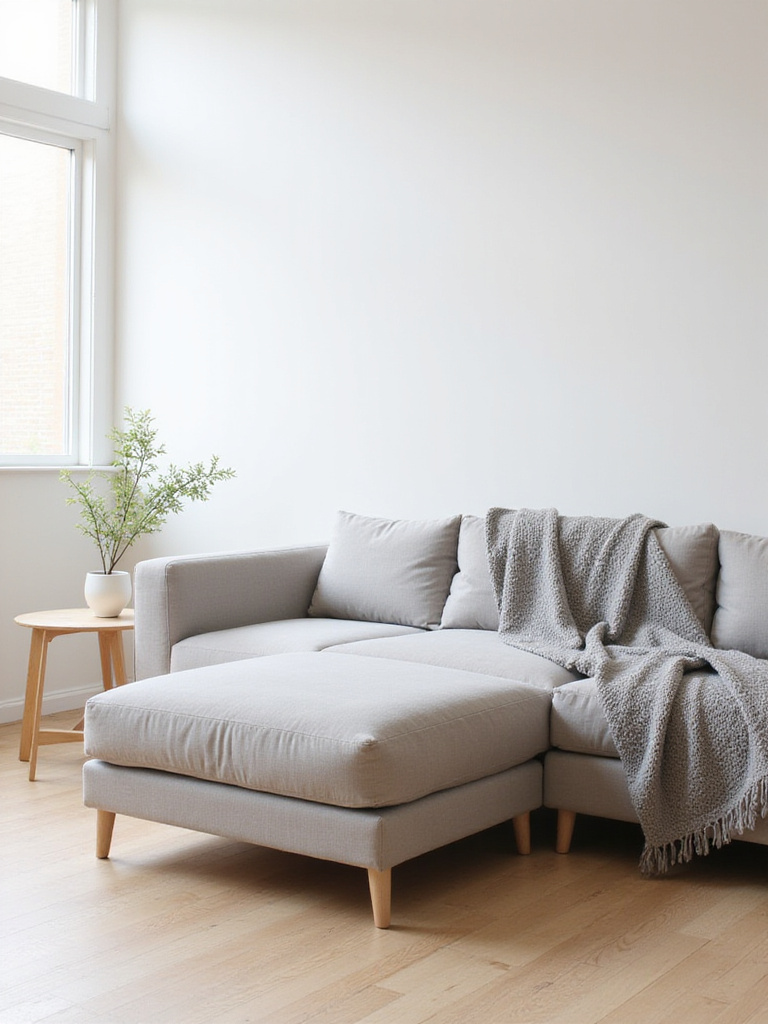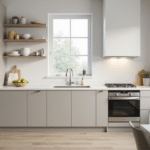Is your living room feeling more like a chaotic storage unit than a serene sanctuary? Do you dream of a space that breathes calm and exudes effortless style, but feel overwhelmed by clutter and excess?
Imagine stepping into a living room that feels spacious, peaceful, and beautifully curated – a space that enhances your well-being rather than draining your energy. This isn’t just a pipe dream; it’s the reality of minimalist living, and it’s within your reach.
1. Embrace the Decluttering Mantra: Start with a Clean Slate
Decluttering is the foundation upon which a minimalist living room is built. Think of it as creating a clean canvas for your design aspirations. It’s about consciously deciding what truly deserves a place in your space and letting go of the rest. A living room overflowing with possessions, regardless of their individual beauty, can feel visually noisy and mentally overwhelming.

Where do you begin when your living room feels like a mountain of belongings? Break down this daunting task into smaller, more manageable steps. Choose a specific area – perhaps a bookshelf, a corner, or even just a single drawer. Use methods like the ‘KonMari Method’ or the ‘one in, one out’ rule to guide your decisions.
- Host a ‘Decluttering Party’ with friends
- Use the four-box method: Label boxes ‘Keep,’ ‘Donate,’ ‘Sell,’ and ‘Trash’
- Remember that studies show clutter can increase stress hormones like cortisol
The game-changer happened as I cleared my living room of unnecessary items – suddenly, the space could breathe, and so could I. Now, with a decluttered foundation, let’s turn our attention to creating a color palette that enhances calm.
2. Choose a Serene Neutral Palette: Foundation for Calm and Versatility
With a decluttered space, the next layer of minimalist magic is color – or rather, the absence of overwhelming color. A neutral palette acts as the serene backdrop for your minimalist living room. It’s more than just a design choice; it’s a conscious decision to foster calm, tranquility, and a sense of spaciousness.

But “neutral” doesn’t mean bland! The spectrum of serene neutrals is surprisingly rich. Think beyond stark white and beige to discover warm whites like cream and ivory, cool whites such as dove gray and pearl, or even soft earth tones like sage or taupe. To prevent a neutral space from feeling flat, introduce visual interest through texture – natural fabrics like linen and cotton, light-toned wood, or brushed metal accents can all add depth without disrupting your serene palette.
- Incorporate natural materials like a woven jute rug or a linen throw blanket
- Start by painting the walls in a light, neutral color as your blank canvas
- Layer different shades within your chosen neutral palette for sophistication
Here’s the catch – your neutral palette isn’t just about aesthetics; it creates the perfect backdrop for natural light to dance through your space, which brings us to our next transformative element.
3. Maximize Natural Light Flow: Open Up Your Space with Brightness
Natural light is the lifeblood of a minimalist living room, amplifying its sense of spaciousness and airiness. It’s not just about looking good; sunlight reduces the need for artificial lighting, contributes to energy efficiency, and has profound psychological benefits – boosting mood and creating a more inviting atmosphere.

Often, obstacles hinder the flow of precious natural light into our living spaces. Heavy curtains, dark-colored walls, overgrown landscaping outside windows, and bulky furniture can all act as barriers. Replace heavy curtains with sheer or light-colored blinds that filter light gently. Paint walls in reflective colors to bounce light around the room. Trim back any landscaping that’s blocking windows, and arrange furniture to avoid obstructing these precious light sources.
“Light is to the spirit what food is to the body.” – Annie Dillard
What unfolded next was transformative – as I removed the barriers to natural light, my minimalist living room began to feel more expansive and energizing. This bright foundation created the perfect setting for considering what furniture would earn its place in my space.
4. Invest in Multi-Functional Furniture: Pieces That Serve Multiple Purposes
In a minimalist living room, every piece of furniture needs to earn its keep. Multi-functional pieces are essential for maximizing space and minimizing clutter. By cleverly serving multiple purposes, each item eliminates the need for additional pieces, contributing to a cleaner, more streamlined aesthetic.

When selecting multi-functional furniture, look for key features like storage capacity (drawers, shelves, hidden compartments), transformation capabilities (convertible sofas, extendable tables), and high-quality, durable materials. Consider a coffee table with hidden storage for remotes and magazines, a sofa bed for overnight guests, or an ottoman that provides both seating and storage. These organized solutions are key to creating the relaxing atmosphere that defines a minimalist living room.
- A sofa bed that transforms into a guest bed
- Storage ottomans that hide blankets and pillows
- Nesting tables that can be separated when needed or stacked to save space
My breakthrough came when I replaced three single-purpose pieces with one multi-functional sectional – suddenly my minimalist living room felt twice as spacious. With furniture that works harder, we can focus on choosing fewer but better quality items.
5. Prioritize Quality Over Quantity: Select Fewer, but Finer Items
Minimalism isn’t about deprivation; it’s about intentionality. In a minimalist living room, this translates to prioritizing quality over quantity. Every item should serve a purpose and, ideally, bring you joy or enhance your life. By focusing on quality, you invest in durable, well-made pieces that are built to last and offer a superior aesthetic experience.

How do you identify these ‘finer’ items when shopping? Look beyond the price tag and examine the materials – solid wood, genuine leather, hand-woven textiles. Pay attention to craftsmanship – sturdy construction, clean finishes, attention to detail. Consider the design and aesthetic appeal – does it align with your personal style and elevate the overall look of the room? Think about longevity – will this item stand the test of time, both in durability and style?
- Invest in a single, high-quality sofa instead of multiple, cheaper seating options
- Set a budget and allocate a larger portion to fewer, higher-quality items
- Don’t be afraid to save up for pieces you truly love
The heart of the matter is creating a living room filled with pieces that will bring joy for years to come. But even with fewer, quality items, you’ll need smart solutions to keep your space organized and clutter-free.
6. Integrate Smart Hidden Storage: Keep Clutter Out of Sight, Out of Mind
The beauty of a minimalist living room lies in its uncluttered surfaces and serene atmosphere. Hidden storage is the unsung hero that makes this possible. It’s not about eliminating possessions entirely, but about strategically concealing items that aren’t essential for daily use or immediate aesthetic appeal.

Where can you effectively incorporate hidden storage? Think creatively about untapped potential in common areas. Look under sofas and ottomans for storage space perfect for blankets or seasonal items. Choose coffee tables with lift-tops or drawers, wall-mounted cabinets with clean lines, and media consoles with concealed doors. Even consider vertical solutions – tall, narrow cabinets maximize storage while occupying minimal floor space.
- Ottoman with lift-top storage for blankets and magazines
- Coffee tables with drawers for remote controls and coasters
- Wall-mounted cabinets that keep items accessible but out of sight
The crucial element is finding storage that blends seamlessly with your minimalist aesthetic. With clutter cleverly concealed, we can turn our attention to grounding the space with texture and warmth.
7. Anchor the Space with a Statement Rug: Add Texture and Warmth Subtly
A rug in a minimalist living room might seem counterintuitive at first, but it’s a powerful tool for grounding the space and adding subtle warmth and texture. Think of a rug as an anchor, defining the seating area and adding visual interest in a quiet, understated way.

Natural fibers are your allies here. Wool offers luxurious softness and durability, while jute and sisal provide a more rustic, textured feel. Consider a rug with a subtle geometric pattern or a high-low pile for added visual interest that remains understated. Size is crucial – a rug should be large enough to anchor the main furniture grouping, with at least the front legs of sofas and chairs resting on it to create a cohesive and grounded feel.
- Layer a smaller, patterned rug over a larger, neutral one for added texture
- Remember that rugs improve acoustics by absorbing sound and reducing echo
- Measure your seating area before purchasing to ensure proper proportions
The stumbling block many people face is choosing a rug that competes for attention rather than complementing the space. With our floor space beautifully anchored, let’s explore how art can bring personality to your minimalist living room.
8. Let Art Be Your Minimalist Accent: Choose One Striking Piece
In a minimalist living room, art takes on heightened significance. Instead of filling walls with numerous pieces, focus on choosing just one striking piece to serve as a focal point. This approach embodies the ‘less is more’ philosophy, allowing the chosen artwork to truly shine and add personality without overwhelming the space.

What types of art work best as a minimalist accent? Consider pieces with bold colors, geometric shapes, abstract designs, or thought-provoking imagery. The size should be carefully considered in relation to the room – a large-scale canvas can make a dramatic statement on an otherwise bare wall. Simple, clean frames are ideal – think thin metal frames in black, silver, or gold, or even unframed canvases if the edges are clean and finished.
- A large-scale abstract painting with a limited color palette placed above a sofa
- Black and white photography in a simple frame
- A single sculptural piece on a minimalist shelf or pedestal
Let me paint you a picture of how transformative a single art piece can be – my minimalist living room felt complete and personal once I hung one large-scale photograph that captured a landscape I love. With your art as a focal point, let’s consider how to control light with minimal window treatments.
9. Opt for Minimalist Window Treatments: Sheer Curtains or Blinds for Light Control
Window treatments in a minimalist living room are all about functionality and subtlety. The goal is to control light and privacy without adding unnecessary visual bulk or ornamentation. They should seamlessly blend with the room’s aesthetic, becoming a quiet backdrop rather than a competing design element.

Sheer curtains offer a beautiful and practical minimalist solution. They diffuse natural light, creating a soft ambiance while maintaining privacy. They add a subtle layer of texture and movement without overwhelming the space. Alternatively, blinds offer precise light control and come in various minimalist-friendly materials like wood, metal, or fabric. Horizontal blinds can visually widen a room, while vertical blinds can make ceilings appear higher.
- Layer sheer curtains with blackout blinds for ultimate light control
- Hang curtains from simple, unadorned rods made of metal or wood
- Choose fabrics and materials that complement your neutral palette
The process goes like this – by selecting window treatments that enhance rather than dominate your space, you create a minimalist living room that feels both serene and functional. Now let’s introduce some life and natural beauty.
10. Introduce Life with Green Plants: A Touch of Nature’s Minimalism
While minimalism often emphasizes the absence of clutter, it doesn’t preclude the introduction of natural elements. Green plants are a perfect way to bring life and vibrancy into a minimalist living room while staying true to the style’s principles. Plants contribute to the aesthetic by introducing simple forms and clean lines, creating a balanced and calming atmosphere.

What types of plants work best? Opt for those with strong, architectural forms and low-maintenance needs. The Snake Plant with its upright, sword-like leaves, the ZZ Plant with its glossy, dark green foliage, or a single statement Monstera leaf in a simple vase all work beautifully. Even a Fiddle Leaf Fig, while requiring more care, makes a striking statement as a single, well-pruned specimen. Avoid overly fussy or flowering plants that demand constant attention and can detract from the minimalist aesthetic.
- Use a single, large plant as a focal point in a corner
- Choose plants that thrive in your living room’s light conditions
- Remember that NASA studies have shown certain houseplants improve air quality
Do you see how huge that is? Adding just one or two carefully chosen plants brings life to your minimalist living room without compromising its clean aesthetic. Now let’s illuminate this thoughtfully designed space.
11. Select Simple and Elegant Lighting: Functional and Unobtrusive Fixtures
Lighting in a minimalist living room is not just about illumination; it’s a critical design element that shapes the ambiance and functionality of the space. Well-chosen artificial lighting enhances brightness, defines zones, and adds warmth without introducing clutter.

Prioritize simplicity, functionality, and unobtrusiveness in your lighting choices. Recessed lighting provides ambient light without taking up visual space. Track lighting offers flexibility and focused illumination. Simple pendant lights, especially above a dining table or reading nook, add a touch of elegance. Layering is key – start with ambient lighting for overall illumination, add task lighting for specific activities like reading, and incorporate accent lighting to highlight artwork or architectural features. Dimmers are essential for controlling light intensity and setting the desired mood.
- Utilize smart lighting systems to control brightness and color temperature
- Remember that warm light (around 2700K) feels relaxing while cool light (around 5000K) feels energizing
- Consider the size of your living room and natural light levels when planning fixtures
The missing piece in many minimalist living rooms is thoughtful lighting that enhances both function and mood. With the right illumination in place, let’s explore how structure and form can further elevate your space.
12. Embrace Clean Lines and Geometric Shapes: Structure and Order in Design
Clean lines and geometric shapes are fundamental building blocks of minimalist design, contributing to a sense of structure, order, and visual clarity. These elements eliminate unnecessary visual clutter, allowing the eye to focus on the essential aspects of the space and creating a calming atmosphere.

How can you effectively incorporate geometric shapes without making your minimalist living room feel cold? Balance is key. Introduce geometric elements through furniture like a rectangular coffee table or cube-shaped side table, or through architectural details like built-in shelving with strong horizontal and vertical lines. Soften potential severity with textures like plush throws, woven rugs, and natural materials. Avoid overwhelming the space with too many sharp angles; instead, mix in softer, more organic forms to create a balanced and inviting environment.
- Create a gallery wall featuring only geometric abstract art prints
- Ensure furniture scale is appropriate for the room size
- Mix angular pieces with softer elements for balance
Here’s what’s happening when you embrace clean lines – your minimalist living room gains a sense of intentional design that feels both sophisticated and restful. But to prevent the space from feeling too stark, we need to add tactile elements.
13. Add Texture for Warmth and Depth: Soften the Space with Tactile Elements
While minimalism celebrates simplicity, an over-reliance on smooth, hard surfaces can create a cold and sterile environment. Texture is essential for introducing visual and tactile interest, adding warmth and depth to a minimalist living room without compromising its aesthetic.

The key is choosing textures that are subtle yet impactful. Think natural materials like woven cotton, linen, wool, wood, and stone. Focus on the inherent texture of the material itself rather than busy patterns. A chunky knit throw, a linen sofa cover, a jute rug, or a raw wood coffee table all add dimension without clutter. Consider contrasting textures, such as pairing a smooth leather chair with a rough-hewn wooden side table. But remember – the ‘less is more’ principle still applies. Choose 3-4 key textural elements and repeat them throughout the room for cohesion.
- Incorporate a chunky knit throw blanket draped over a sofa
- Add a single textured element first and observe how it changes the feel
- Remember that touching different textures can have a calming, grounding effect
You might be wondering if adding texture contradicts minimalism, but it’s actually essential for creating a minimalist living room that feels inviting rather than austere. Now let’s organize this textured space for maximum functionality.
14. Define Zones for Functionality: Create Purposeful Areas Within the Room
In a minimalist living room, maximizing functionality is key. Zoning, or creating purposeful areas within the room, prevents the space from feeling like a single, undefined area. Instead, it creates distinct spots for different activities like reading, working, or relaxing, contributing significantly to a sense of calm and order.

What are some common functional zones to consider? A relaxation zone centered around a comfortable sofa, a reading nook with a chair and lamp, a small workspace tucked into a corner, or an entertainment area focused on the television. Visual separation can be achieved in minimalist ways without walls – area rugs define zones beautifully, furniture placement can create subtle division, and different lighting schemes for each zone further distinguish the areas.
- Use a low bookshelf as a room divider providing storage and visual separation
- Start by identifying your primary activities in the living room
- Create zones based on how you actually use the space, not how you think you should
The tricky part is creating distinct zones while maintaining the open, uncluttered feel of a minimalist living room. With functional zones established, let’s explore how empty space can actually enhance your design.
15. Master the Art of Negative Space: Let Empty Areas Enhance the Design
Negative space, often called white space, is a crucial yet misunderstood element of minimalist design. It’s not just ‘unused’ space; it’s an active design element that shapes how we perceive the entire room. In a minimalist living room, negative space allows carefully chosen items to breathe and stand out, creating a sense of calm, openness, and sophistication.

How can you intentionally incorporate negative space without making your living room feel bare? Consciously consider the relationship between objects and the space around them. Leave breathing room around furniture groupings. Instead of filling every wall with art, choose one statement piece and allow it to ‘float’ with plenty of surrounding empty space. Think of negative space as a visual pause, allowing the eye to rest and appreciate the details of your carefully curated items.
- Create a focal point, like a statement sofa, with generous open space around it
- Before adding anything new, remove one or two items and observe how the space feels
- Remember that in design, negative space is sometimes called ‘figure-ground relationship’
The breakthrough came when I realized that the empty spaces in my minimalist living room weren’t “missing” anything – they were intentional design elements creating visual harmony. This understanding leads us to the core philosophy that ties everything together.
16. Live by the ‘Less is More’ Philosophy: Edit Ruthlessly and Keep it Simple
The driving force behind minimalist design is the philosophy of ‘Less is More.’ In a minimalist living room, this principle means that the impact and beauty of the space are enhanced by intentional restraint. It’s not about deprivation, but about carefully selecting each item for its purpose and aesthetic value, prioritizing quality over quantity.

To truly embrace this philosophy, ‘ruthless editing’ is necessary. This means actively decluttering and removing items that don’t serve a purpose or bring joy, allowing the remaining pieces to breathe. ‘Keeping it simple’ translates to focusing on clean lines, neutral color palettes, and uncluttered surfaces. This simplicity creates a sense of peace and tranquility, allowing the architecture of the room and carefully selected furniture to take center stage.
- Create a ‘maybe’ box for items you’re unsure about discarding
- Start with a single surface and style it minimally with only a few chosen items
- Remember that the phrase ‘Less is More’ comes from architect Ludwig Mies van der Rohe
Let me show you another perspective – minimalism isn’t about having nothing; it’s about making room for what matters most. And in a minimalist living room, comfortable seating definitely matters.
17. Prioritize Comfortable Minimalist Seating: Style and Relaxation Combined
Minimalism doesn’t mean sacrificing comfort for style. A truly minimalist living room should be both aesthetically pleasing and deeply comfortable, especially when it comes to seating. The key is balancing minimalist aesthetics with maximum comfort in your choices.

What types of seating work best? Modular sofas offer flexibility and the ability to rearrange them for different needs. Sectionals can work if they have a low profile and clean design. A single statement armchair is often more impactful than multiple smaller ones. Floor cushions provide casual seating in a relaxed setting. Keep the palette neutral and muted – shades of gray, beige, white, and soft blues or greens are ideal. Introduce texture through fabric choices like linen, wool, or subtle weaves, and add a few simple throw pillows for comfort without clutter.
- Incorporate a daybed as a versatile option that can also function as a guest bed
- Test seating options in person before purchasing to ensure comfort
- Choose pieces with clean lines but generous cushioning
It works something like this – when your minimalist living room has truly comfortable seating, you create a space that’s not just beautiful to look at but actually enjoyable to use. Now let’s ensure every item in that space serves a purpose.
18. Decorate with Purposeful Functional Items: Beauty in Utility
In a minimalist living room, every item should ideally serve a purpose. This principle extends to decoration as well. Decorating with purposeful functional items means choosing objects that are both beautiful and useful, contributing to both the aesthetic and the functionality of your space.

What are some examples of purposeful functional items? A stylish storage ottoman provides seating and storage. A beautiful blanket ladder displays throws while keeping them organized. A well-designed floor lamp provides lighting and acts as a design element. Curated collections of art books serve as both decorative objects and sources of inspiration. Even plants, beyond their aesthetic appeal, improve air quality and contribute to a healthier living environment.
- Use a vintage trunk as a coffee table for storage and character
- Before buying any new item, ask what purpose it will serve and if it adds beauty
- Remember that the Bauhaus movement, which influenced minimalism, emphasized functional design
The implications are staggering when you shift to this mindset – suddenly every item in your minimalist living room has earned its place through both beauty and function. Finally, let’s ensure everything has its proper place.
19. Practice Intentional Item Placement: Every Piece Should Have Its Place
The final touch in creating a minimalist living room is practicing intentional item placement. This means that every single item in your space should have a designated place and purpose. This directly combats clutter and visual noise, the very antithesis of minimalism, and makes maintaining order much easier.

Intentional placement significantly contributes to functionality. By assigning specific locations for items, you create a more efficient space. Remotes should have a designated spot near the seating area, books should reside on a shelf or in a basket, and throws should be neatly folded when not in use. Common mistakes include using surfaces as temporary storage, neglecting vertical space, and not considering the flow of the room. Leaving mail on the coffee table or stacking books haphazardly disrupts the clean, intentional feel of a minimalist living room.
- Create a designated charging station for electronics
- Start by decluttering before finding places for remaining items
- Remember that studies show a decluttered environment reduces stress and improves focus
Picture it this way – when everything has its place in your minimalist living room, you’re not just creating visual order, but also making your daily life smoother and more peaceful.
Conclusion: Embrace the Magic of Minimalist Living
Transforming your living room with minimalist magic is more than just a design project; it’s an invitation to embrace a more intentional and peaceful way of living. By decluttering, choosing a serene palette, maximizing natural light, and focusing on quality and functionality, you create a space that is both aesthetically beautiful and deeply beneficial for your well-being.
Minimalism in the living room isn’t about stark emptiness, but about carefully curating a space that supports your life, promotes calm, and allows you to truly relax and recharge. As you implement these 19 transformative strategies, you’ll discover that less truly can be more, unlocking a sense of spaciousness, serenity, and magic within your home.
Your minimalist living room becomes not just a showcase of design principles, but a personal sanctuary that reflects what matters most to you – and nothing more.






